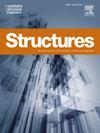Mechanical behavior of coral concrete-filled aluminum alloy square tube columns subjected to eccentric loading
IF 3.9
2区 工程技术
Q1 ENGINEERING, CIVIL
引用次数: 0
Abstract
Coral aggregate concrete (CAC), a composite material consisting of coral aggregates, ordinary Portland cement, and seawater, demonstrates significant potential for application in island buildings. However, the use of seawater introduces corrosive ions such as Cl- and SO42- into CAC, leading to the corrosion of reinforcement. In recent years, the integration of CAC with aluminum alloy square tubes has emerged as an improved anti-corrosion strategy due to the excellent corrosion resistance of aluminum alloy. In this study, 15 CAC-filled aluminum alloy square tube columns (CCAT) were fabricated, considering three concrete strengths (C20, C30, and C40), three eccentricities (e = 20 mm, 40 mm, and 60 mm), and three tube thicknesses (t = 2 mm, 4 mm, and 6 mm). The ultimate bearing load, ductility, and stiffness were investigated in relation to these variables, respectively. Additionally, a finite element analysis (FEA) model was developed to simulate the eccentric compressive behavior of CCAT, and a new eccentric bearing capacity model was proposed. The results indicated that increasing the aluminum alloy tube thickness enhanced the ultimate bearing load and stiffness, while increasing the eccentricity reduced both stiffness and bearing capacity. Furthermore, the findings were validated through FEA, and 12 extended analysis results were also presented. A novel bearing capacity model, incorporating equivalent constraint theory, was established. This model demonstrated accurate predictions compared to existing code models.
求助全文
约1分钟内获得全文
求助全文
来源期刊

Structures
Engineering-Architecture
CiteScore
5.70
自引率
17.10%
发文量
1187
期刊介绍:
Structures aims to publish internationally-leading research across the full breadth of structural engineering. Papers for Structures are particularly welcome in which high-quality research will benefit from wide readership of academics and practitioners such that not only high citation rates but also tangible industrial-related pathways to impact are achieved.
 求助内容:
求助内容: 应助结果提醒方式:
应助结果提醒方式:


